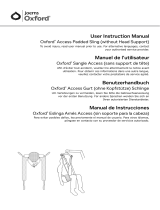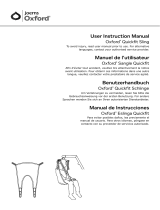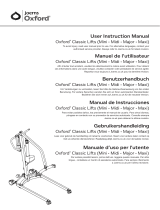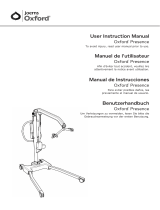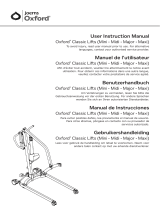
Oxford®
Eslinga Standaid Deluxe
17
Español
Introducción
La eslinga Standing Deluxe es una eslinga fácil de poner y apta para colocar al paciente de pie y como
soporte. No es una eslinga de uso general y cada paciente deberá ser evaluado individualmente para
determinar su aptitud. La eslinga Transport Deluxe es una eslinga de uso general fácil de poner, que
proporciona un soporte total al paciente. No es apta para pacientes con ambas piernas amputadas, ni
para levantar al paciente desde la posición horizontal.
Pedidos Especiales de Arneses
Existen determinadas ocasiones en las que se requiere el uso de material, dimensiones y otros factores diferentes
de la especicación estándar. Tenga en cuenta que, al margen de cualquier referencia especíca de modelo,
debe seguir respetando las directrices de montaje, limpieza y seguridad. Por cualquier consulta, póngase en
contacto con su representante autorizado de servicio de Oxford o directamente con Joerns Healthcare.
Declaración de uso previsto
Un arnés es una pieza en movimiento y forma parte del equipo de manipulación que se utiliza con un el-
evador mecánico para facilitar el traslado de un paciente. Se compone de un trozo de tela especialmente
diseñado y construido que se coloca por debajo o alrededor de un paciente antes de acoplarlo a la barra
separadora o la base de soporte de un elevador para levantar, transferir o descender al paciente. La selec-
ción y uso correctos del arnés y combinación de piezas de elevación brindan una transferencia más segura
y reducen los riesgos asociados a la manipulación manual.
Una persona competente y responsable debe llevar a cabo una evaluación minuciosa de los riesgos antes de
usar cualquier arnés, para asegurarse de que la elección, el método de posicionamiento en el arnés y el pro-
cedimiento de transferencia se hayan calculado correctamente para el paciente en cuestión. Para obtener más
información, póngase en contacto con su proveedor de servicios autorizado de Oxford o Joerns Healthcare.
SOLAMENTE PARA USO CON ELEVADORES ACTIVO.
Vida útil estipulada previa al mantenimiento
La vida útil estipulada de un arnés Oxford variará dependiendo del uso y del cuidado que le brinde, y del
seguimiento de las instrucciones de lavado presentes en la guía del usuario. Otros factores, como la tem-
peratura del lavado, los detergentes, la frecuencia de uso y el peso del paciente tendrán un impacto en la
vida útil del arnés. Joerns Healthcare recomienda revisar los arneses cada vez que vaya a usarlos para
garantizar la seguridad del paciente. Si los arneses se encuentran descoloridos, rotos, cortados o rasgados
ya no son elementos seguros, por lo que debe desecharlos y sustituirlos de inmediato. Es un requisito de
LOLER (Regulaciones sobre operaciones para levantar pacientes y equipos de elevación de 1998) que los
arneses se sometan a una revisión y aprobación completas. Para obtener más información, póngase en
contacto con su proveedor de servicios autorizado de Oxford o Joerns Healthcare.
Notificación de incidentes graves
En caso de que se produzca un incidente grave durante el uso de este producto, que afecte al paciente
y/o al proveedor de cuidados, debe comunicarse con el fabricante del producto o el distribuidor autorizado.
Si el incidente se produce dentro de la Unión Europea (UE), también se debe informar a la autoridad local
competente del Estado miembro.
ADVERTENCIA
• OXFORD RECOMIENDA UTILIZAR PRODUCTOS AUTÉNTICOS OXFORD. Los sistemas Oxford
de arneses y elevación tienen un diseño que los hace compatibles entre sí. Para obtener información
y consejos específicos acerca del uso y compatibilidad de los arneses, consulte la etiqueta del
arnés, o bien comuníquese con su distribuidor local de mercado o con Joerns Healthcare.
• Por la seguridad del paciente y del proveedor de cuidados, antes de utilizar cualquier arnés, se
debe llevar a cabo una evaluación exhaustiva de riesgo para comprobar la determinación de la
elección correcta de arnés, el método de posicionamiento en el mismo y el procedimiento de
transferencia para el paciente.
• Antes de cada utilización, INSPECCIONE el arnés y las costuras. La utilización de arneses
descoloridos, rasgados, cortados, deshilachados o rotos es insegura y podría ocasionar
lesiones severas e inclusive la muerte del paciente.
• NO altere los arneses. Deseche o destruya los arneses desgastados.
• NO deje NUNCA un paciente desatendido.
• NO exceda la capacidad estipulada para la eslinga o el elevador.
• NO intente modificar la posición del paciente tirando de las presillas del arnés.





























